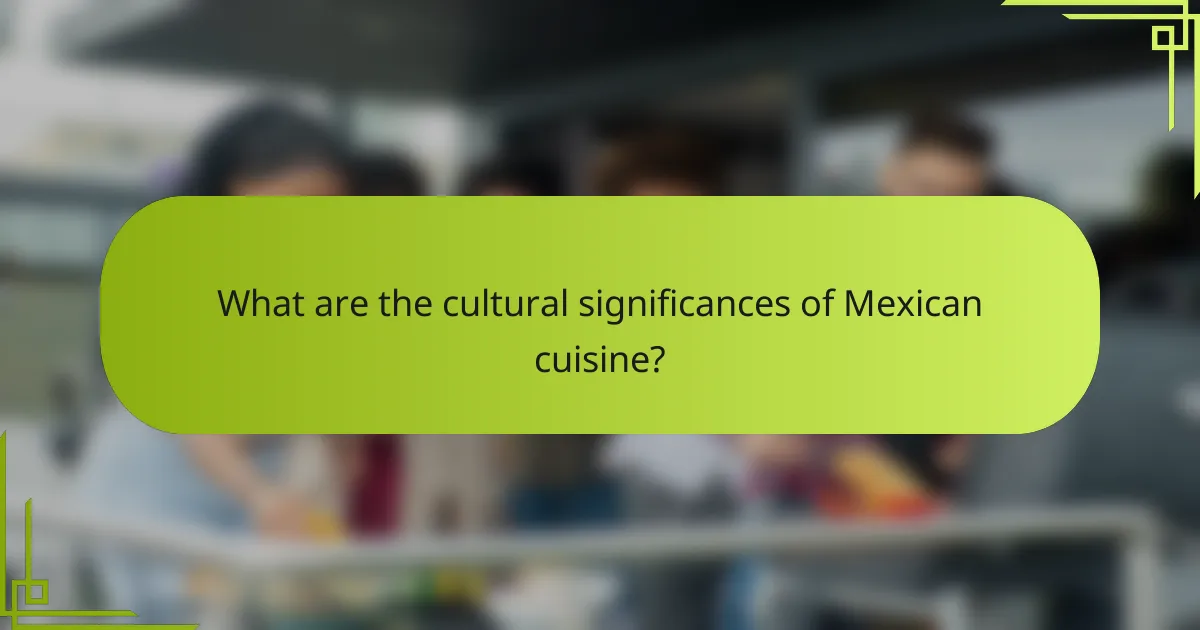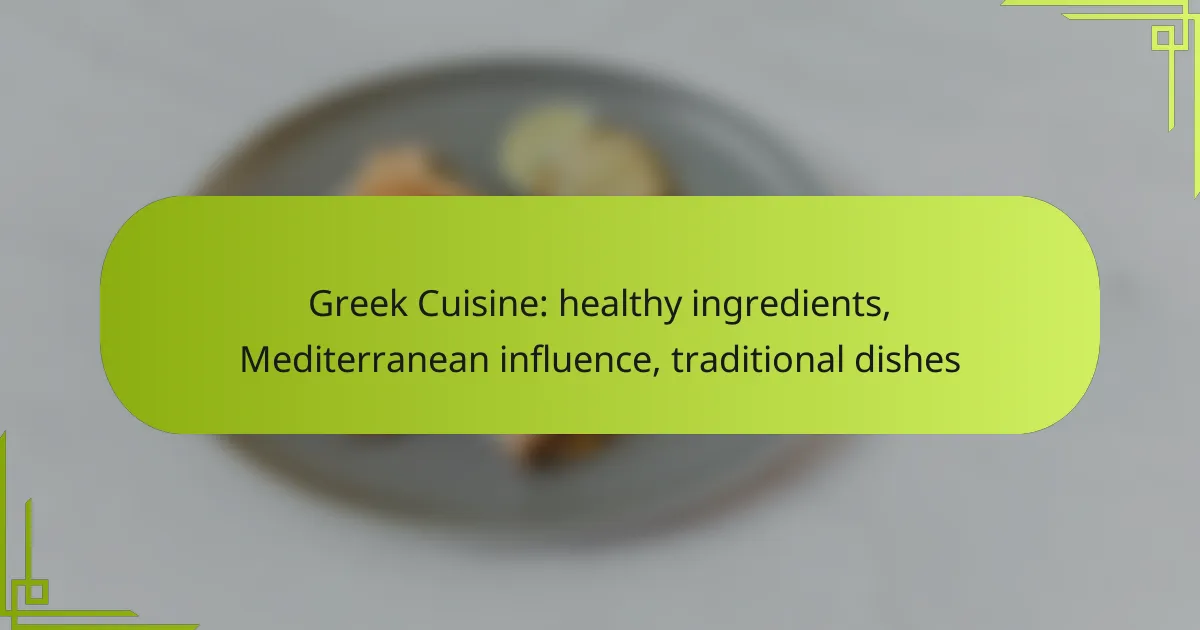Mexican cuisine is a vibrant tapestry of colors and bold spices, deeply rooted in the country’s rich cultural heritage. Each dish, from Tacos al Pastor to Mole Poblano, not only tantalizes the taste buds but also embodies the history and traditions of Mexico. Preparing authentic Mexican food at home involves using fresh ingredients and traditional techniques, allowing for a genuine culinary experience that celebrates community and identity.

What are the best Mexican dishes to try in Canada?
In Canada, some of the best Mexican dishes to try include Tacos al Pastor, Enchiladas Verdes, Chiles en Nogada, Mole Poblano, and Tamales. These dishes showcase vibrant flavors and ingredients that reflect the rich culinary heritage of Mexico.
Tacos al Pastor
Tacos al Pastor are a must-try for anyone exploring Mexican cuisine in Canada. These tacos feature marinated pork cooked on a vertical spit, similar to shawarma, and are typically served with pineapple, onions, and cilantro. The combination of sweet and savory flavors makes them a crowd favorite.
When ordering Tacos al Pastor, look for places that prepare their tortillas fresh and offer a variety of salsas to enhance the flavor. Pairing them with a refreshing drink like horchata can elevate your dining experience.
Enchiladas Verdes
Enchiladas Verdes consist of corn tortillas filled with meat or cheese, smothered in a tangy green tomatillo sauce. This dish is often topped with sour cream, cheese, and fresh cilantro, providing a delightful mix of textures and flavors. It’s a comforting option that showcases the essence of Mexican cooking.
For a satisfying meal, consider ordering Enchiladas Verdes with a side of Mexican rice and refried beans. This combination not only enhances the dish but also adds nutritional balance to your meal.
Chiles en Nogada
Chiles en Nogada is a traditional Mexican dish that features poblano peppers stuffed with a flavorful mixture of meat, fruits, and spices, all topped with a creamy walnut sauce and pomegranate seeds. The dish is often served during the Mexican Independence Day celebrations, symbolizing the colors of the national flag.
When trying Chiles en Nogada, look for restaurants that prepare the sauce from scratch, as this significantly enhances the dish’s flavor. It’s a seasonal dish, so availability may vary, especially around September.
Mole Poblano
Mole Poblano is a rich, complex sauce made from a blend of ingredients, including chocolate, chili peppers, and various spices. It is commonly served over chicken or turkey, creating a dish that is both savory and slightly sweet. The depth of flavor in Mole Poblano is unmatched, making it a highlight of Mexican cuisine.
When ordering Mole Poblano, inquire about the preparation method, as traditional recipes can take hours to develop. Pairing it with rice and tortillas can help balance the richness of the sauce.
Tamales
Tamales are a traditional Mexican dish made from masa (corn dough) filled with various ingredients, such as meats, cheeses, or vegetables, and wrapped in corn husks before being steamed. They are often enjoyed during celebrations and family gatherings, making them a beloved comfort food.
For the best experience, try a variety of tamales, including sweet and savory options. Many restaurants offer tamales as part of a platter, allowing you to sample different flavors and fillings in one meal.

How to prepare authentic Mexican cuisine at home?
To prepare authentic Mexican cuisine at home, focus on using fresh ingredients, traditional techniques, and bold flavors. Emphasizing regional specialties will enhance the authenticity of your dishes.
Essential ingredients for Mexican cooking
Key ingredients in Mexican cooking include staples like corn, beans, and chili peppers. Fresh herbs such as cilantro and spices like cumin and oregano are also vital for achieving the characteristic flavors.
Other important components are tomatoes, onions, and lime, which add freshness and acidity. Using high-quality ingredients, especially local produce, can significantly elevate your dishes.
Traditional cooking techniques
Traditional Mexican cooking techniques include methods like roasting, frying, and steaming. For instance, roasting tomatoes and peppers enhances their flavors before blending them into salsas or sauces.
Another common technique is using a molcajete, a stone mortar and pestle, to grind spices and make salsas. This method not only preserves the texture but also infuses the dish with a rich, authentic taste.
Popular recipes to start with
Begin your journey with simple recipes like tacos, enchiladas, and guacamole. Tacos can be filled with various ingredients, allowing for creativity while keeping the essence of Mexican cuisine.
Enchiladas, made by rolling tortillas around fillings and smothering them in sauce, are another great option. For a refreshing side, prepare guacamole, which combines ripe avocados, lime, and cilantro for a vibrant dip.

What are the cultural significances of Mexican cuisine?
Mexican cuisine holds deep cultural significance, reflecting the country’s history, traditions, and social values. It serves as a medium for expressing identity and community, often intertwined with rituals and celebrations.
Role in Mexican celebrations
Food plays a central role in Mexican celebrations, marking important events such as weddings, birthdays, and religious festivals. Dishes like tamales and mole are often prepared for these occasions, symbolizing abundance and hospitality.
During holidays like Día de los Muertos, specific foods are offered to honor deceased loved ones, showcasing the connection between culinary practices and cultural heritage. These meals not only nourish but also tell stories of family and tradition.
Influence of indigenous cultures
The roots of Mexican cuisine can be traced back to indigenous cultures, which have significantly shaped its flavors and ingredients. Staples such as corn, beans, and chili peppers were central to ancient diets and remain foundational in modern cooking.
Traditional cooking methods, like nixtamalization of corn, highlight the influence of indigenous practices that enhance flavor and nutrition. This connection to the past enriches the culinary landscape and preserves cultural identity.
Connection to family traditions
Mexican cuisine fosters strong family bonds through shared cooking and dining experiences. Recipes are often passed down through generations, creating a sense of continuity and belonging within families.
Gathering around the table for meals reinforces familial ties and provides an opportunity to share stories and traditions. This communal aspect of dining is integral to Mexican culture, emphasizing the importance of family and togetherness.

How to choose the right Mexican restaurant in Canada?
To choose the right Mexican restaurant in Canada, look for authenticity in the menu, ambiance, and customer reviews. Prioritize establishments that use fresh ingredients and traditional cooking methods to ensure a genuine experience.
Criteria for authentic cuisine
Authentic Mexican cuisine is characterized by its use of fresh, high-quality ingredients and traditional recipes. Look for restaurants that feature staples like corn tortillas, fresh salsas, and a variety of regional dishes such as mole or tamales.
Additionally, consider the cooking methods employed. Authentic restaurants often use techniques like grilling, roasting, and slow-cooking, which enhance the flavors of the dishes. A diverse menu that includes options from various regions of Mexico can also indicate authenticity.
Top-rated Mexican restaurants in major cities
In cities like Toronto, Vancouver, and Montreal, several Mexican restaurants consistently receive high ratings. For instance, in Toronto, places like “La Carnita” and “El Catrin” are known for their vibrant atmosphere and authentic flavors.
Vancouver boasts popular spots such as “La Taqueria” and “Sal y Limon,” which focus on fresh ingredients and traditional recipes. In Montreal, “Tacos Frida” and “El Santo” are favorites for their unique takes on classic dishes. Always check recent reviews to ensure quality remains high.

What are the health benefits of Mexican ingredients?
Mexican ingredients offer numerous health benefits, primarily due to their rich nutritional profiles and natural medicinal properties. Incorporating these ingredients into your diet can enhance overall wellness and provide essential nutrients.
Nutritional value of beans
Beans are a staple in Mexican cuisine and are packed with protein, fiber, and essential vitamins and minerals. They are low in fat and can help regulate blood sugar levels, making them an excellent choice for maintaining energy and supporting heart health.
Common varieties include black beans, pinto beans, and kidney beans, each offering unique flavors and textures. A typical serving of beans can provide around 15 grams of protein and significant amounts of iron and magnesium, contributing to a balanced diet.
Health benefits of avocados
Avocados are rich in healthy fats, particularly monounsaturated fats, which are beneficial for heart health. They also contain a variety of vitamins, including E, K, and several B vitamins, along with potassium and fiber.
Regular consumption of avocados may help lower cholesterol levels and reduce the risk of heart disease. A single avocado can provide about 20% of the daily recommended intake of potassium, which is vital for maintaining proper blood pressure.
Spices and their medicinal properties
Many spices used in Mexican cooking, such as chili peppers, cumin, and oregano, possess medicinal properties that can enhance health. For instance, chili peppers contain capsaicin, which may boost metabolism and reduce inflammation.
Cumin is known for its digestive benefits, while oregano has antioxidant properties that can help combat oxidative stress. Incorporating these spices into meals not only adds flavor but also contributes to overall health and wellness.










